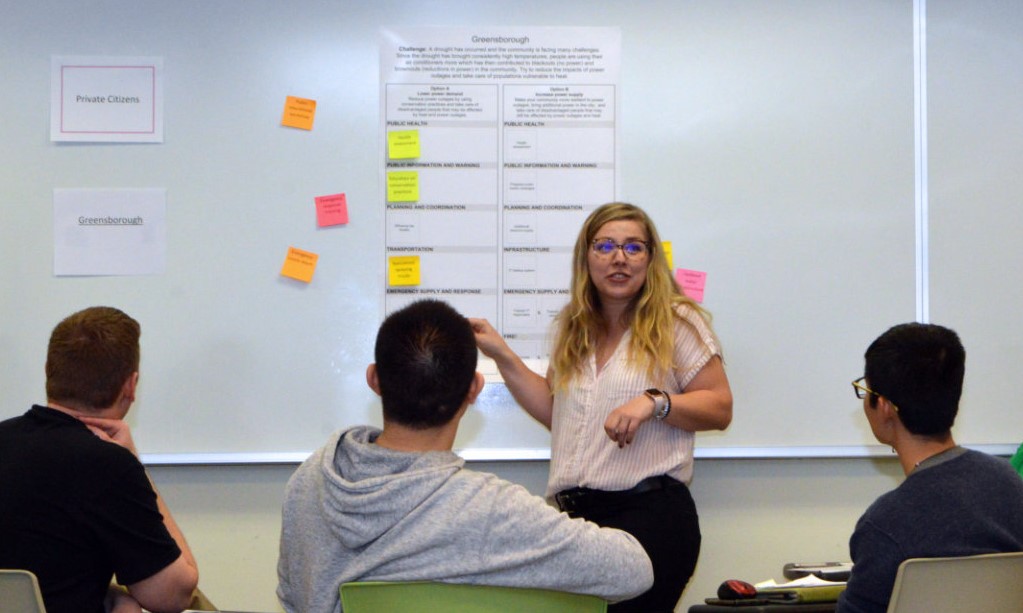
A drought has hit and your community is now especially susceptible to poor water quality and quantity, which may affect the tourism and also the diverse plant and animal species in the area. The majority of touristic activities occur on a reservoir and the river flowing out of it. How do you best conserve the natural resources of the area without threatening the incomes coming from tourism and recreation?
This is one of the scenarios that a prolonged drought makes a community face, and it’s one of six that participants will have to grapple with in a new role-playing game created by the National Drought Mitigation Center.
Ready for Drought is an activity that has players work in teams of six to address the strain drought puts upon a community from the perspectives of private citizens, local decision makers, responders, business and industry and communities. In the process it details the scope of drought, and the resources that can reduce its effects. Players take on the roles of firefighter, mayor, water manager, TV reporter, scientist, rancher, governor and up to 29 more, because each brings a different set of skills and viewpoints when it comes to mitigating drought.
The game was modeled after the suite of Extreme Event games created by LabX and presented by the National Academy of Sciences, said Ready for Drought’s creator, NDMC graduate assistant Markéta Poděbradská.
“They have three different extreme events: hurricane, flooding, earthquakes,” Poděbradská said. “We really liked the format of their game and wanted to do something similar, adapted to drought.”
Poděbradská was taking a class in which she was assigned to develop a classroom activity and, after consulting with NDMC climatologist Deborah Bathke, went to work on Ready for Drought, and became part of NDMC’s scenario-building team.
Poděbradská observed a drought tournament hosted by the North Platte Natural Resources District in Scottsbluff. There, Bathke and other NDMC staff refereed and moderated the game, which had been tailored to the participants and the area. It involved the effect of drought on North Platte River Basin, the Sandhills and the city.
"We were there to help facilitate,” Poděbradská said. “They put a lot of energy and money into developing these scenarios of drought and what it would look like when there was a drought in that area of certain severity and what would it mean to hydrology or to the streams there. They had these very specific scenarios.”
Ready for Drought provides a general scenario for the Missouri River Basin that can be played in about 90 minutes.
“The goal was to create a simple, low-cost game, where the full package can be downloaded online,” Poděbradská said. “Anybody who wants to either have an icebreaker for a drought meeting or have an educational game for university or high school settings can download it and have something in their hands that they can do on their own.”
The game requires a minimum of 12 players, a facilitator, a projection screen and little else. The rules and setup material are available at drought.unl.edu/Education/DroughtGame.aspx.
The game is set along the Missouri River Basin and features six fictional communities, from a 600,000-person city (Newdale) to a 580-person ranching community (Silvergrass). Players receive a collection of resource cards that correspond to the role they’ve been given. For instance, a business representative might have capability to drill new wells, update water infrastructure or prepare media messages. The challenge is to select resources that might be useful for coping with drought in different communities with different needs.
Poděbradská said that successful utilization of resources and building coalitions with representatives from other regions is the key part of the game.
"I think that there's a strength in cooperation,” Poděbradská said.
Last spring, Poděbradská, Bathke, Mary Noel, NDMC master’s student, and Michael Hayes, professor of applied climatology, led a trial run of the game played by Nebraska School of Natural Resources students and SNR and NDMC staff. The players provided feedback after Ready for Drought concluded, and Poděbradská said she used the comments to tweak the game in advance of its release this spring. Even in its development stage, many students said the game was an enlightening experience.
“This is a big, informative, and well-organized activity,” one student wrote. “It is definitely effective for potentially building awareness about drought and the need for stakeholder engagement and interaction.”
Another commented on the card selection process, saying it was interesting because you have to explore “the pool of your mind” to help determine how it will be useful to your team.
“I really enjoyed the drought activity and thought it went really well,” another wrote. “I do think it was effective in understanding planning for droughts and giving a little perspective from a community decision-maker’s side of the equation rather than the citizen perspective I think most of us are used to. It was very beneficial to see the decision-making process people have to go through in order to determine how they will prepare their communities for a disaster. I thought it did a good job of showing the need for stakeholder engagement, but did a better job showing the need for community cooperation.”
Support to create the game was provided by the National Integrated Drought Information System.
Courtesy the National Drought Mitigation Center at SNR
More details at: http://drought.unl.edu